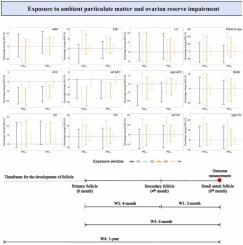Exposure to ambient particulate matter and ovarian reserve impairment among reproductive age women in China
IF 11.3
1区 环境科学与生态学
Q1 ENGINEERING, ENVIRONMENTAL
引用次数: 0
Abstract
Ovarian aging, characterized by a decline in ovarian reserve, is a critical concern in female reproductive health. However, the evidence linking ambient air pollution exposure with ovarian reserve impairment remains limited. We aimed to estimate the association between exposure to fine particulate matter (PM2.5) and respirable particulate matter (PM10) and key indicators of ovarian reserve, including antral follicle count (AFC), ovarian volume (OV), anti-Müllerian hormone (AMH), follicle-stimulating hormone (FSH), estradiol (E2), luteinizing hormone (LH), FSH/LH ratio, and inhibin B (INHB). The cohort consisted of women attending an infertility clinic at the Tongji Reproductive and Environmental (TREE) study between 2018 and 2020. We used multivariate linear and Poisson regression models to estimate the association between PM2.5 and PM10 exposure and these ovarian reserve indicators. Our results showed that PM2.5 and PM10 exposure were associated with a reduction in AFC and an increase in E2 levels, highlighting the adverse effects of ambient air pollution on ovarian reserve. Our findings have important public health implications, emphasizing the urgent need for interventions to safeguard female reproductive health and reduce exposure to ambient air pollution.

环境颗粒物暴露与中国育龄妇女卵巢储备功能损害
以卵巢储备功能下降为特征的卵巢衰老是女性生殖健康的一个重要问题。然而,将环境空气污染暴露与卵巢储备功能受损联系起来的证据仍然有限。我们的目的是估算细颗粒物(PM2.5)和可吸入颗粒物(PM10)暴露与卵巢储备功能主要指标之间的关系,这些指标包括前卵泡计数(AFC)、卵巢体积(OV)、抗穆勒氏管激素(AMH)、卵泡刺激素(FSH)、雌二醇(E2)、黄体生成素(LH)、FSH/LH比率和抑制素B(INHB)。队列由2018年至2020年间在同济生殖与环境(TREE)研究不孕不育门诊就诊的女性组成。我们使用多变量线性回归模型和泊松回归模型来估计PM2.5和PM10暴露与这些卵巢储备指标之间的关联。我们的研究结果表明,PM2.5和PM10暴露与AFC的降低和E2水平的升高有关,凸显了环境空气污染对卵巢储备功能的不利影响。我们的研究结果具有重要的公共卫生意义,强调了采取干预措施保障女性生殖健康和减少环境空气污染暴露的迫切需要。
本文章由计算机程序翻译,如有差异,请以英文原文为准。
求助全文
约1分钟内获得全文
求助全文
来源期刊

Journal of Hazardous Materials
工程技术-工程:环境
CiteScore
25.40
自引率
5.90%
发文量
3059
审稿时长
58 days
期刊介绍:
The Journal of Hazardous Materials serves as a global platform for promoting cutting-edge research in the field of Environmental Science and Engineering. Our publication features a wide range of articles, including full-length research papers, review articles, and perspectives, with the aim of enhancing our understanding of the dangers and risks associated with various materials concerning public health and the environment. It is important to note that the term "environmental contaminants" refers specifically to substances that pose hazardous effects through contamination, while excluding those that do not have such impacts on the environment or human health. Moreover, we emphasize the distinction between wastes and hazardous materials in order to provide further clarity on the scope of the journal. We have a keen interest in exploring specific compounds and microbial agents that have adverse effects on the environment.
 求助内容:
求助内容: 应助结果提醒方式:
应助结果提醒方式:


